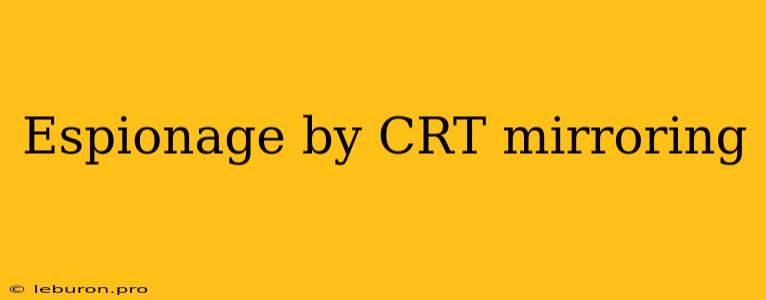Espionage has been a significant concern in the digital age, and with the advancement of technology, new methods are continuously emerging. One such method gaining prominence is espionage by CRT mirroring. CRT mirroring, a technique employed by malicious actors to exploit vulnerabilities in CRT monitors, has emerged as a sophisticated method for gathering sensitive data and compromising systems. This article delves into the intricacies of this technique, exploring its mechanisms, potential threats, and countermeasures.
Understanding CRT Mirroring: A Stealthy Threat
CRT mirroring is a relatively new form of espionage that leverages the inherent weaknesses of Cathode Ray Tube (CRT) monitors. These monitors, once ubiquitous, are still prevalent in certain environments, including government offices, military installations, and financial institutions. While CRT monitors have been largely replaced by modern LCD and LED displays, their vulnerabilities remain, posing a serious threat to sensitive information.
How CRT Mirroring Works
The technique relies on the principle of electromagnetic interference (EMI). CRT monitors emit a low-level electromagnetic field as a byproduct of their operation. This field can be intercepted and analyzed to extract data displayed on the screen, including sensitive information like login credentials, financial data, and confidential documents.
The process involves the following steps:
-
Installation: A malicious actor installs a specialized device or software that acts as a data receiver near the CRT monitor. This receiver could be a small, covert device disguised as a common household item or even a custom-built hardware component.
-
Data Acquisition: The receiver intercepts the electromagnetic field emitted by the monitor and converts the analog signal into digital data.
-
Decoding and Extraction: The captured data is then decoded and processed to extract meaningful information from the screen display.
The Vulnerability of CRT Monitors
CRT monitors are vulnerable to this technique due to their analog nature. The display mechanism relies on an electron beam that interacts with phosphor on the screen to generate the image. This process creates a magnetic field that can be intercepted and analyzed. Modern LCD and LED monitors, on the other hand, use digital signals and do not emit significant electromagnetic radiation, making them less susceptible to espionage by CRT mirroring.
Consequences of CRT Mirroring
Espionage by CRT mirroring can have severe consequences, ranging from information theft to system compromise. The stolen data can be used for various malicious purposes, including:
- Financial fraud: Accessing sensitive financial information, such as bank account details, credit card numbers, and stock trading information.
- Industrial espionage: Obtaining trade secrets, research data, and competitive intelligence.
- Political espionage: Interfering with government operations and gaining access to sensitive information about national security.
- Cyberattacks: Using stolen credentials to gain unauthorized access to computer systems and networks.
The Silent Threat of CRT Mirroring
Espionage by CRT mirroring is a particularly insidious form of attack as it is often silent and undetectable. Victims may not realize their systems have been compromised until it is too late. This stealthy nature makes it highly effective for espionage purposes.
Countermeasures and Mitigation Strategies
While CRT mirroring presents a significant threat, there are countermeasures that can be employed to mitigate the risk:
- Replace CRT monitors: The most effective way to address this vulnerability is to replace outdated CRT monitors with modern LCD or LED displays.
- Use EMI shielding: Installing EMI shielding around CRT monitors can help reduce the electromagnetic field emitted by the device.
- Implement physical security measures: Limiting access to workstations with CRT monitors and using physical security devices can reduce the chances of unauthorized installations.
- Regular security audits: Conduct regular security audits to detect any suspicious activity, including the presence of unauthorized devices or software.
- Awareness and education: Educating users about the risks of espionage by CRT mirroring and implementing security best practices can help prevent attacks.
Conclusion
Espionage by CRT mirroring is a sophisticated and evolving threat that must be taken seriously. By understanding the mechanisms of this technique and implementing appropriate countermeasures, organizations can protect their sensitive information and mitigate the risks associated with CRT mirroring. As technology continues to evolve, it is essential to stay ahead of emerging threats and adopt comprehensive security practices to safeguard against espionage by CRT mirroring and other cyber threats.
